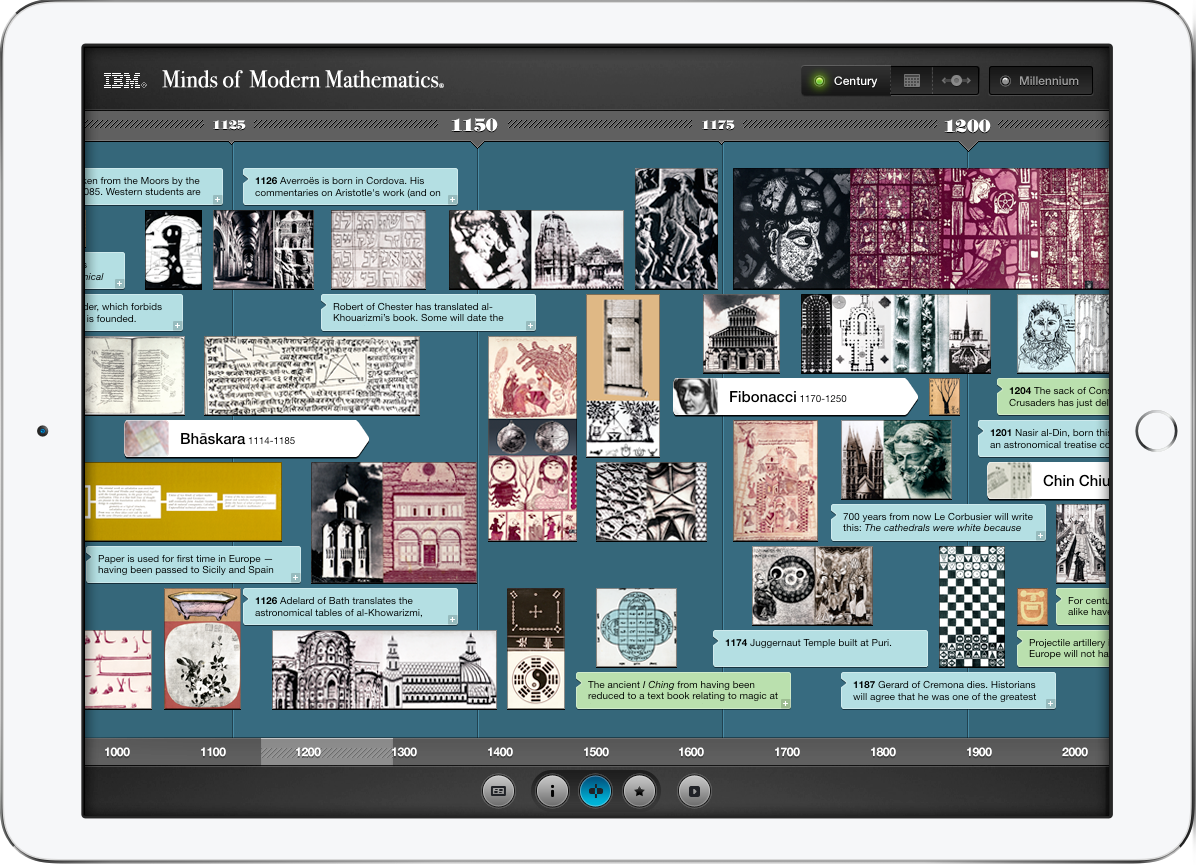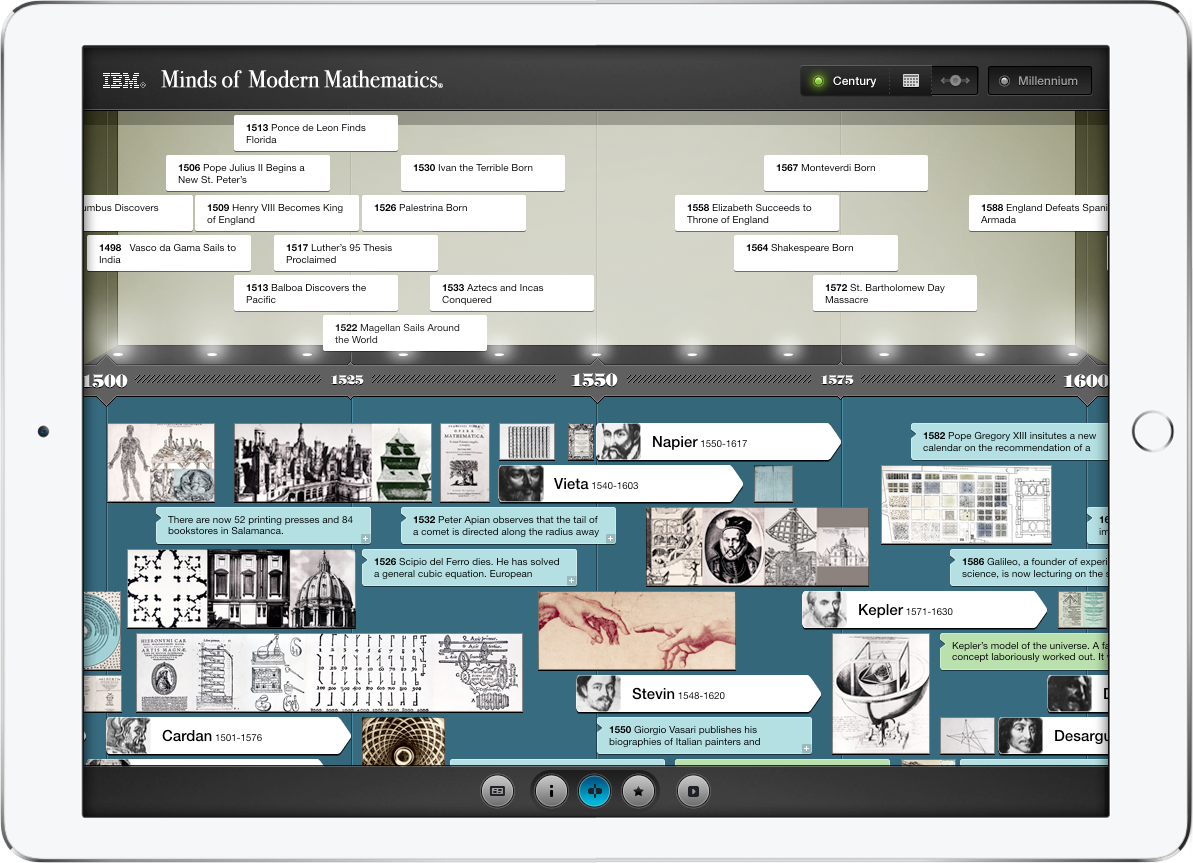An Interactive Journey That Spans 1,000 Years of Mathematics History
Honoring the legacy of Charles and Ray Eames with IBM’s most popular iPad app ever
In 1961, Thomas Watson Jr., co-founder of IBM, commissioned legendary design team Charles and Ray Eames to create an installation for the California Science Museum. They shared a passion for mathematics and it quickly evolved into something extraordinary—an interactive exhibition called Mathematica… A World of Numbers and Beyond. This beautiful and engaging learning experience played a major role at the 1964/1965 New York World’s Fair and has since been enjoyed across multiple locations by countless millions. Today, copies of the exhibition remain permanently installed at The New York Hall of Science, The Museum of Science in Boston, and The Henry Ford Museum in Michigan.
(L) Mathematica at The Museum of Science in Boston, (R) Charles and Ray Eames inspect the Men of Modern Mathematics timeline
At the center of the exhibition is a stunning 50-foot timeline that represents the rich interplay between mathematicians, culture, and historical events over the past millennium. In celebration of IBM’s 100th anniversary, my challenge was to reimagine the original timeline for a completely new format—Apple’s very first iPad. The result was the Minds of Modern Mathematics app, a digital experience that allows today’s students, teachers, and avid learners to interact with Charles and Ray Eames’ creation in new and exciting ways.
A poster version of the timeline
Inside the app
The default view shows one century of history. Users may swipe horizontally to move forward or back in time.
Swiping down orients users in time by revealing important events unrelated to mathematics.
Pinching allows users to transition from the view of a single century to a view of the entire millennium.
Users may tap a mathematician to learn more about who they were and how they contributed to the field.
Similarly, tapping a cultural artifacts reveals more about it.
While designing the app, it was important for me to think about how an iPad might offer users new ways to experience the original content. In observing how people interacted with the installation, I noticed something very interesting: their eyes would typically dart back and forth across the 50-foot wall, focusing only momentarily on the largest or most visually impactful objects before moving on to the next. In fact, nobody seemed progress through the timeline chronologically and they often ignored any written text altogether. I had to admit that my own experience mirrored what I saw in others.
It was to clear to me at this point that despite the beauty of Charles and Ray Eames’ creation, it was not very usable. In fact, it was nearly impossible to absorb all the content and formulate a comprehensive understanding of how mathematics evolved over the millennium. Maybe that was the point, but I doubt it.
I was eager to solve this problem, but I also wanted to preserve the integrity and pay homage to the magnificent artistry of the original. For this reason, I decided that orienting the iPad to landscape would offer an experience that more or less reproduces the original but in an interactive format, and turning the device to portrait would allow users to view the content in a completely new way: one object at a time, in chronological order. For the first time in 50 years, audiences could enjoy in the entirety of Eames’ history of mathematics as it unraveled.
Over the course of their careers, Charles and Ray Eames produced over 125 short films, many of which were focused on educational topics. The Minds of Modern Mathematics comes with nine of these films, including one of their most famous, 2n: A Story of the Power of Numbers (1961).
Finally, if users want to interact with the original timeline, an ultra-high resolution photograph of the poster version is also included.
“I just lost the last 6 hours in this—and I think I’ve hardly scratched the surface. Smartly done, comprehensive, hard to believe, and at times mesmerizingly odd.”
An overwhelming quantity of content
In addition to inventorying (and painstakingly photographing) the 495 objects on the timeline, it was also essential to create an ontology of each of the four main object types that were identified and the different permutations of assets associated with every one. I gave the object types names: (1) Mathematicians, (2) Culture artifacts, (3) Historical developments, and (4) Historical events. The result was the following hierarchy:
- Mathematicians - People who have contributed to the advent of modern mathematics. Includes the following content types:
- Name (always)
- Birth year (always)
- Death year (always)
- Locations where they were active (always)
- Long form biography (always)
- Mathematical achievements (always)
- Profile image (always)
- Supplemental images (sometimes)
- Cultural artifacts - Art and culture that influenced the mathematicians. Includes the following content types:
- Year artifact was created or made public (always)
- One or more images (always)
- Descriptions of images (sometimes)
- Long form description (sometimes)
- Historical developments - New knowledge or incidents that directly influenced the field of mathematics. Includes the following content types:
- Year (always)
- Description (always)
- Historical events - Orienting events unrelated to mathematics. Includes the following content types:
- Year (always)
- Description (always)
- Name (always)
- Birth year (always)
- Death year (always)
- Locations where they were active (always)
- Long form biography (always)
- Mathematical achievements (always)
- Profile image (always)
- Supplemental images (sometimes)
- Year artifact was created or made public (always)
- One or more images (always)
- Descriptions of images (sometimes)
- Long form description (sometimes)
- Year (always)
- Description (always)
- Year (always)
- Description (always)










